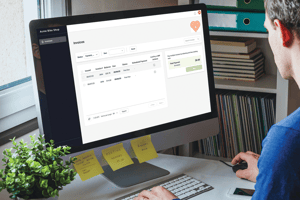THE MORE YOU KNOW
What is accounts receivable automation?
AR (accounts receivable) automation does what it says: It automatically handles the time-consuming manual tasks that go into your B2B company’s AR process.
AR automation solves your accounts receivable challenges by seamlessly:
- Sending out digital invoices as soon as work is done, or products are sold.
- Reminding your customers when payments are due.
- Reconciling invoices to payments.
Continue below to learn more about automating accounts receivable automation and what it means for B2B companies.
Terms you should know:
Accounts Receivable (AR)
Accounts receivable (AR) represent money owed to companies for goods, services, or sales. They are essential to a B2B company’s working capital and cash flow, which is why they are expected to be paid by the customer on or near a certain date.
Accounts Receivable Aging
Accounts receivable aging is a way of categorizing unpaid receivables according to the length of time the debt is past due, such as 1-30 days, 31-60 days, etc. This provides valuable insight into how effectively a company collects its invoices and monitors its cash flow.
Account Reconciliation
Account reconciliation is the process of comparing two sets of records to ensure that all transaction information is accurate and up-to-date. It is used to ensure the accuracy of financial statements, verify vendor payments, check for fraud, and identify any discrepancies. By reconciling accounts regularly, organizations can reduce risk and increase transparency in their financial processes.
Automated Clearing House (ACH)
Automated Clearing House (ACH) transactions are electronic payments that allow customers to transfer funds quickly and securely from one bank account to another. ACH transactions reduce processing costs, increase accuracy, improve efficiency, and are significantly faster than traditional paper methods of payment.
Cash Flow
Cash flow is the cycle of money coming in and going out of your business. It’s an essential part of any company’s financial health, as it affects everything from budgeting to hiring and expansion. A key metric for cash flow management is Days Sales Outstanding (DSO), which measures how long it takes customers to pay their invoices.
Days Sales Outstanding (DSO)
Days Sales Outstanding (DSO) is the average number of days it takes to receive payment for a sale. DSO is a measure of how quickly a company collects its accounts receivable (i.e. how quickly customers pay their bills). Companies want to reduce their DSO to strengthen their cash flow. The faster your business gets paid, the stronger your financials.
Order-to-Cash
Order-to-cash is a business process that begins with an order from a customer, and ends with the collection of payment from this same customer. It covers all activities in between such as invoicing, goods receipt, and accounts receivable confirmation.
Automation matters to B2B companies.
Accounts Receivable automation has a direct impact on your bottom line by freeing up cash, saving money, and increasing efficiency.
- Gets you paid faster than ever
- Increases your cash flow
- Frees your team from labor-intensive accounting chores
- Eliminates human error
AR automation from Bill360 also adds the following benefits:
- Provides your customers with a B2C-like payment experience
- Reduces risk of check fraud
- Built specifically for small-to-medium sized B2B companies
- Focused 100% on AR
- Live guided setup and access to US-based, in-house support team
- Exclusive features like customer portals, buyer-managed payer wallets, real-time customer communication, and more
More time. Faster payments. Stronger cash flow.
|
AR automation reduces the manual process by up to 85%i |
|
|
Companies automating more than half of their AR process reduce DSO by 32%ii |
|
Invalid or incorrect purchase order information leads to 49% of buyer-seller disputesiii |
|
i Emergen Research ii PYMNTS iii CFO.com |
